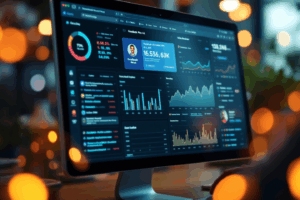
Present Simple Tense 2
English Blogs “Let’s Learn, Explore, and Connect to the World” Present Simple Tense 2 II. Understanding the Present Simple Tense Definition and Structure At its


 In the digital age, advertising has transcended traditional boundaries, evolving into a dynamic force that drives consumer behavior and business growth. Among the myriad of digital marketing strategies, targeted advertising stands out as a cornerstone, enabling businesses to deliver their messages to the right audience at the right time. This precision not only enhances the effectiveness of campaigns but also maximizes return on investment by minimizing the wastage of resources on uninterested parties.
In the digital age, advertising has transcended traditional boundaries, evolving into a dynamic force that drives consumer behavior and business growth. Among the myriad of digital marketing strategies, targeted advertising stands out as a cornerstone, enabling businesses to deliver their messages to the right audience at the right time. This precision not only enhances the effectiveness of campaigns but also maximizes return on investment by minimizing the wastage of resources on uninterested parties.
 With billions of users and robust data analysis, Facebook reigns supreme in online advertising. It provides marketers with an unmatched reach across various demographics, making it crucial for targeting specific audiences. Facebook’s advanced ad tools allow for precise targeting based on factors like age, interests, and online behavior, guaranteeing that ads reach the most relevant viewers.
With billions of users and robust data analysis, Facebook reigns supreme in online advertising. It provides marketers with an unmatched reach across various demographics, making it crucial for targeting specific audiences. Facebook’s advanced ad tools allow for precise targeting based on factors like age, interests, and online behavior, guaranteeing that ads reach the most relevant viewers.
This blog cuts to the chase, showing you how to use Facebook’s targeting features. Whether you’re a newbie advertiser or a marketing pro, this guide will teach you to target your ideal audience with pinpoint accuracy. Learn how to leverage demographics, interests, and user behavior to craft genuinely connect ads. By mastering these targeting methods, you’ll reach precisely who you want and maximize the return on your ad spend.
 Facebook Ads represent one of the most powerful tools in the digital marketer’s arsenal. They leverage Facebook’s extensive user network to deliver tailored advertisements directly to a selected audience. This system operates within the Facebook platform, including Instagram and Messenger, allowing advertisers to place their messages in front of users not just based on traditional ad spaces but also integrated naturally into their social feeds.
Facebook Ads represent one of the most powerful tools in the digital marketer’s arsenal. They leverage Facebook’s extensive user network to deliver tailored advertisements directly to a selected audience. This system operates within the Facebook platform, including Instagram and Messenger, allowing advertisers to place their messages in front of users not just based on traditional ad spaces but also integrated naturally into their social feeds.
 At its core, Facebook Ads are a form of paid advertising used by businesses and individuals to promote products, services, or brands on the Facebook platform. These ads can appear in several places, including the main news feed, the right column of Facebook on desktop, within Stories, and across other Facebook-owned properties like Instagram and Messenger. Facebook offers a toolbox of ad formats to fit any marketing need. Choose from videos, images, carousels, slideshows, or even dynamic product ads to create campaigns that drive brand recognition, generate leads, or boost sales.
At its core, Facebook Ads are a form of paid advertising used by businesses and individuals to promote products, services, or brands on the Facebook platform. These ads can appear in several places, including the main news feed, the right column of Facebook on desktop, within Stories, and across other Facebook-owned properties like Instagram and Messenger. Facebook offers a toolbox of ad formats to fit any marketing need. Choose from videos, images, carousels, slideshows, or even dynamic product ads to create campaigns that drive brand recognition, generate leads, or boost sales.
 Facebook ads go far and wide, reaching nearly everyone on the planet. Powerful targeting tools pinpoint the right audience using all sorts of info – age, location, what they’re into, and even how they use Facebook. Plus, Facebook’s innovative system prioritizes showing your ads to people most likely to care, so you get the biggest bang for your buck.
Facebook ads go far and wide, reaching nearly everyone on the planet. Powerful targeting tools pinpoint the right audience using all sorts of info – age, location, what they’re into, and even how they use Facebook. Plus, Facebook’s innovative system prioritizes showing your ads to people most likely to care, so you get the biggest bang for your buck.
 Facebook goes beyond just showing your ads to a lot of people—it helps you see how well they’re working, too. With its analytics tools, you can track your campaigns in real time, see who sees your ads, and even measure whether people are taking the actions you want. This lets you constantly improve your marketing strategy to get the best results.
Facebook goes beyond just showing your ads to a lot of people—it helps you see how well they’re working, too. With its analytics tools, you can track your campaigns in real time, see who sees your ads, and even measure whether people are taking the actions you want. This lets you constantly improve your marketing strategy to get the best results.
 In the digital marketing world, the scattergun approach of traditional advertising is being swiftly replaced by targeted advertising. This strategy is essential not only for maximizing the effectiveness of advertising campaigns but also for enhancing user experience by aligning content with user preferences and needs.
In the digital marketing world, the scattergun approach of traditional advertising is being swiftly replaced by targeted advertising. This strategy is essential not only for maximizing the effectiveness of advertising campaigns but also for enhancing user experience by aligning content with user preferences and needs.
Facebook advertising isn’t a scattershot approach. With data by their side, marketers can find exactly who they’re looking for, even super-specific groups. This laser focus means messages resonate better, leading to more customers at a lower cost. Even small businesses can compete with giants by using Facebook to target the perfect audience for their budget.
 Through Facebook ads, marketers can achieve a high degree of granularity in their advertising efforts, making them an essential element of modern digital marketing strategies. Whether the goal is to increase brand recognition, boost website traffic, or drive sales, Facebook’s sophisticated targeting capabilities make it possible to achieve these objectives with remarkable efficiency and effectiveness.
Through Facebook ads, marketers can achieve a high degree of granularity in their advertising efforts, making them an essential element of modern digital marketing strategies. Whether the goal is to increase brand recognition, boost website traffic, or drive sales, Facebook’s sophisticated targeting capabilities make it possible to achieve these objectives with remarkable efficiency and effectiveness.
Targeting by demographics is an essential part of Facebook advertising. It lets marketers zoom in on the exact people who would be interested in what they’re selling, making their campaigns way more effective.
 Demographic targeting involves segmenting the market based on attributes such as age, gender, location, marital status, education level, and more. Facebook, with its vast database, offers advertisers the ability to zero in on these demographics with precision, crafting messages that resonate with each group’s unique preferences and lifestyles.
Demographic targeting involves segmenting the market based on attributes such as age, gender, location, marital status, education level, and more. Facebook, with its vast database, offers advertisers the ability to zero in on these demographics with precision, crafting messages that resonate with each group’s unique preferences and lifestyles.
 Age: Hit the right age! You have the freedom to choose who sees your Facebook ads based on their age. This way, your message reaches people at the right stage in life. For instance, a fancy skincare company might target folks between 30 and 50 since they’re more likely to be interested in (and able to afford) those top-of-the-line products.
Age: Hit the right age! You have the freedom to choose who sees your Facebook ads based on their age. This way, your message reaches people at the right stage in life. For instance, a fancy skincare company might target folks between 30 and 50 since they’re more likely to be interested in (and able to afford) those top-of-the-line products.
 Location: Geo-targeting allows ads to be shown to users based on specific locations, from broad regions to particular cities or even neighborhoods. This is particularly useful for local businesses that want to attract nearby customers, such as restaurants or retail stores. A local gym might target ads to Facebook users within a 10-mile radius to drive local sign-ups.
Location: Geo-targeting allows ads to be shown to users based on specific locations, from broad regions to particular cities or even neighborhoods. This is particularly useful for local businesses that want to attract nearby customers, such as restaurants or retail stores. A local gym might target ads to Facebook users within a 10-mile radius to drive local sign-ups.
 Gender: Products or services often appeal more to one gender than another. For instance, a brand that sells women’s athletic wear will target female Facebook users to increase the relevance and effectiveness of their advertising.
Gender: Products or services often appeal more to one gender than another. For instance, a brand that sells women’s athletic wear will target female Facebook users to increase the relevance and effectiveness of their advertising.
 Marital Status: This can be a crucial factor in marketing products related to relationship stages, such as wedding services targeting engaged users or baby products aimed at newly married couples.
Marital Status: This can be a crucial factor in marketing products related to relationship stages, such as wedding services targeting engaged users or baby products aimed at newly married couples.
 Education Level: Targeting based on education can help tailor the messaging and product offerings based on the audience’s educational background. For example, educational software for advanced learning can be targeted at users who have indicated a higher education level.
Education Level: Targeting based on education can help tailor the messaging and product offerings based on the audience’s educational background. For example, educational software for advanced learning can be targeted at users who have indicated a higher education level.
 The primary benefit of demographic targeting is the ability to reach a specific audience that is most likely to be interested in what you’re offering, thereby increasing engagement and conversion rates. This method also helps optimize marketing budgets by focusing resources on segments that offer the highest potential returns.
The primary benefit of demographic targeting is the ability to reach a specific audience that is most likely to be interested in what you’re offering, thereby increasing engagement and conversion rates. This method also helps optimize marketing budgets by focusing resources on segments that offer the highest potential returns.
 However, demographic targeting does have its limitations. Relying solely on demographic data might lead to assumptions that overlook the diversity within each group. Users within the same demographic can have vastly different interests and behaviors, which means advertisers might miss potential customers who fall outside their targeted demographics but may still be interested in the product.
However, demographic targeting does have its limitations. Relying solely on demographic data might lead to assumptions that overlook the diversity within each group. Users within the same demographic can have vastly different interests and behaviors, which means advertisers might miss potential customers who fall outside their targeted demographics but may still be interested in the product.
Additionally, demographic targeting can sometimes lead to ad fatigue if not combined with other types of targeting, as users repeatedly see the same ads, which might not address their individual preferences or changing behaviors.
 Interest-based targeting is a powerful method that Facebook offers to help advertisers reach users based on their hobbies, likes, and activities on the platform. This approach goes beyond demographic factors, diving deeper into the audience’s psyche and preferences, allowing for more personalized and relevant advertising.
Interest-based targeting is a powerful method that Facebook offers to help advertisers reach users based on their hobbies, likes, and activities on the platform. This approach goes beyond demographic factors, diving deeper into the audience’s psyche and preferences, allowing for more personalized and relevant advertising.
Interest targeting on Facebook uses data from user activities, including their likes, follows, app usage, and even interactions with content like posts and ads. This data is then used to build a profile that reflects the user’s interests, which advertisers can tap into to deliver highly tailored content. This method is incredibly valuable because it aligns the advertising message with the user’s existing preferences, increasing the likelihood of engagement and conversion.
Finding and selecting the right interests to target on Facebook involves several steps:
Facebook provides insights and analytics that can help advertisers understand the common interests of their audience. This tool is invaluable for refining targeting strategies.
This feature allows advertisers to see what interests their target demographic commonly shares, including other brands they like, entertainment choices, and lifestyle preferences.
Within the ad setup process, you can type keywords related to your product or service, and Facebook will suggest related interests that users have shown engagement with.
Look at interests related to your competitors or industry leaders to find a relevant audience interested in similar offerings.

An online store specializing in outdoor sports equipment used interest-based targeting to reach Facebook users interested in hiking, climbing, and outdoor activities. By aligning their ads with seasonal hiking tips and promoting location-specific gear recommendations, the brand saw a 50% increase in click-through rates and a 30% increase in sales for the targeted products.

An online education platform offering programming courses targeted users who showed interest in technology, coding languages, and leading tech figures. The campaign was customized with testimonials from industry professionals and highlighted courses that catered directly to developing skills in high demand within the tech industry. As a result, enrollment increased by 40% from these targeted groups.

A health app targeting individuals interested in fitness, nutrition, and wellness tailored ads featuring personalized fitness plans and diet tracking features. By targeting users who followed fitness influencers and liked related products, the app’s installation rate increased significantly, demonstrating a direct correlation between targeted interests and user engagement.
Facebook goes beyond demographics – it can target people based on what they actually do online. This lets you show your ads to folks who are already interested in similar things, making them much more likely to care about what you’re offering.
Behavioral targeting on Facebook involves analyzing activities like purchase history, website visits, app usage, and engagement with previous ads. This data helps advertisers understand user habits and preferences, enabling them to deliver ads that are more likely to result in a conversion. The essence of behavioral targeting lies in its ability to predict future behaviors by understanding past actions, making it a dynamic tool for enhancing advertising precision and effectiveness.
Facebook tracks a variety of user behaviors, each offering unique insights into user preferences and likely future actions. Some of the key behaviors tracked include:
 Information on past purchases, both on and off Facebook, gives advertisers clues about what products users might be interested in buying again.
Information on past purchases, both on and off Facebook, gives advertisers clues about what products users might be interested in buying again.
 Data on whether users access Facebook from mobile devices, desktops, or tablets, helping tailor ads to the device most commonly used.
Data on whether users access Facebook from mobile devices, desktops, or tablets, helping tailor ads to the device most commonly used.
 Tracks indications of recent travels or regular commuting, useful for local businesses or travel-related services.
Tracks indications of recent travels or regular commuting, useful for local businesses or travel-related services.
 Insights into which types of posts and ads users have interacted with in the past, including likes, shares, and comments.
Insights into which types of posts and ads users have interacted with in the past, including likes, shares, and comments.
 Data collected from websites and apps connected with Facebook, through tools like Facebook Pixel and SDK, which track user interactions outside of Facebook itself.
Data collected from websites and apps connected with Facebook, through tools like Facebook Pixel and SDK, which track user interactions outside of Facebook itself.
Knowing how people behave online can really improve your Facebook ads. Why? Because you can target folks based on what they’re likely to do next. Here are some tips to make the most of this:
Facebook retargeting can help win those sales back. It lets you show ads to people who checked out your stuff but didn’t buy, reminding them why they liked it in the first place.
By analyzing the behaviors of existing customers, Facebook can help advertisers find new users who exhibit similar behavior, expanding their potential customer base with high precision.
Behavioral data enables the creation of personalized ads that reflect the users’ interests and past actions. For example, if a user frequently purchases books in a specific genre, a bookstore can target ads to them featuring new arrivals in that genre.
Behavioral insights can also inform when users are most active on Facebook, allowing advertisers to schedule their ads during these peak times to increase visibility and engagement.
 The true power of Facebook advertising lies not just in using demographic, interest, or behavioral targeting in isolation but in the strategic integration of these methods to create a nuanced, multi-faceted approach to targeting. By combining these layers, advertisers can refine their audience to those who are most likely to engage and convert, optimizing their ad spend and increasing the relevance of their campaigns.
The true power of Facebook advertising lies not just in using demographic, interest, or behavioral targeting in isolation but in the strategic integration of these methods to create a nuanced, multi-faceted approach to targeting. By combining these layers, advertisers can refine their audience to those who are most likely to engage and convert, optimizing their ad spend and increasing the relevance of their campaigns.
Integrating various targeting methods begins with clearly understanding the campaign’s objectives and the audience’s characteristics. Here’s how to combine these targeting methods effectively:
Before you get too fancy, start with the basics. Think about who your ideal customer is: their age, gender, and where they live. This is like the foundation of your target audience, and you can add more details later.
Layer interest targeting on top of your demographic base to focus on users who fit the basic profile and have expressed interests that align with your product or service. For example, targeting middle-aged male demographics with interest in luxury cars if you’re marketing high-end automotive accessories.
Level up your targeting! Once you have the basics, use what people do online to find the perfect audience. For example, target folks who visited your website or liked your other ads. They’re already showing interest, so they’re more likely to care about what you’re offering now.
Test and Learn: Use A/B testing to compare different combinations of targeting criteria to see which mix delivers the best performance in terms of engagement and conversions.
Use Advanced Facebook Tools: Take advantage of Facebook’s Audience Insights and other advanced tools to gain a deeper understanding and continuously refine your targeting strategy.
Monitor and Optimize: Keep an eye on campaign performance and adjust your targeting parameters as needed. Consumer behaviors and interests can shift, so ongoing optimization is crucial.
 The balance between broad and narrow targeting is crucial. Too broad, and you risk diluting your message across an audience that may not be interested; too narrow, and you may miss potential customers who could convert if given the chance. The goal is to find a sweet spot where the targeting is specific enough to be relevant yet not so exclusive that it omits potential leads. This balance maximizes both reach and relevance, ensuring optimal use of your advertising budget.
The balance between broad and narrow targeting is crucial. Too broad, and you risk diluting your message across an audience that may not be interested; too narrow, and you may miss potential customers who could convert if given the chance. The goal is to find a sweet spot where the targeting is specific enough to be relevant yet not so exclusive that it omits potential leads. This balance maximizes both reach and relevance, ensuring optimal use of your advertising budget.
The secret sauce? Combining everything we talked about—age, interests, what people do online—to build the perfect target audience for your Facebook ads. When your message reaches exactly the right people, your campaigns will be way more effective.
 Throughout this blog, we have explored the robust targeting capabilities of Facebook Ads, which include demographic, interest-based, and behavioral targeting. Each method offers unique advantages that, when combined, gives edge to your ads.
Throughout this blog, we have explored the robust targeting capabilities of Facebook Ads, which include demographic, interest-based, and behavioral targeting. Each method offers unique advantages that, when combined, gives edge to your ads.
Imagine a bullseye. Demographics are like the outer ring, hitting a broad audience of a certain age, location, or gender. Interest targeting gets you closer to the center, finding people who like things related to what you’re selling. Finally, behavioral targeting hits the bullseye by showing your ads to people who’ve already shown interest in similar products or taken actions online that suggest they might be a perfect fit.
 The integration of these targeting strategies enables marketers to craft campaigns that are not just seen but are also relevant and compelling to the audience they reach. This relevance is key to driving higher engagement rates, increasing conversions, and ultimately maximizing the return on investment in advertising spend.
The integration of these targeting strategies enables marketers to craft campaigns that are not just seen but are also relevant and compelling to the audience they reach. This relevance is key to driving higher engagement rates, increasing conversions, and ultimately maximizing the return on investment in advertising spend.
As you plan your next Facebook ad campaign, consider employing a layered targeting approach to tap into the right audience segments with laser precision. Don’t just set it and forget it! Try out different targeting combinations and see what works best. Keep tweaking and improving your campaigns, and soon you’ll be a Facebook ad pro. Put these strategies into action today and take your digital marketing to the next level!

English Blogs “Let’s Learn, Explore, and Connect to the World” Present Simple Tense 2 II. Understanding the Present Simple Tense Definition and Structure At its

English Blogs “Let’s Learn, Explore, and Connect to the World” Past Continuous 6 VI. Expanding Your Practice with the Past Continuous Mastering the Past Continuous
Discover your inner editing abilities with this complete guide made for beginners to master the art of video editing smoothly. ‘A Beginner’s Guide to Video Editing: Be a Pro in Just 24 Hours’ is your way to discover the secrets of professional-grade editing within a day.



